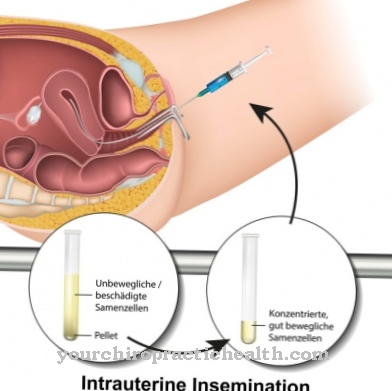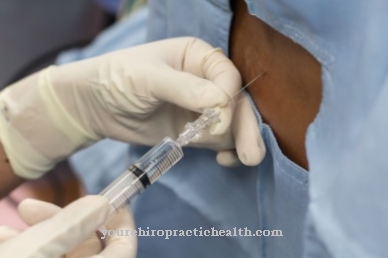As transurethral prostate resection is a surgical procedure in urology. Diseased tissue is removed from the male prostate gland.
What is Transurethral Prostate Resection?

For transurethral prostate resection (TURP) is a urological surgical method. As part of the procedure, the surgeon removes prostate tissue that has changed pathologically from the man's prostate gland without making an external incision through the urethra.
The method also bears the names Prostate resection, transurethral resection of the prostate or transurethral prostatectomy. It is one of the minimally invasive surgical procedures. This means that a resectoscope, a special endoscope, is used and the pathological tissue is removed with a wire loop.
The foundation stone for performing transurethral prostate resection was laid in 1879 by the German urologist Maximilian Nitze (1848-1906) with the introduction of cystoscopes with electric lighting. He later also developed surgical cystoscopes and cauterization when removing urinary bladder tumors. One of the predecessors of transurethral prostate resection was the transurethral punch resection of the prostate gland developed in 1909.
In 1926 Max Stern mixed the punch instrument with a cystoscope and a wire loop. In this way the prototype of the resectoscope was created. After Joseph McCarthy made some improvements in 1931, the medical instrument became known as the Stern McCarthy resectoscope.
Function, effect & goals
In medicine, a distinction is made between transurethral prostate resection and transurethral urinary bladder resection (TURB). The TURB is used to treat superficial bladder cancer, while the TURP removes obstacles that prevent urine from flowing through the prostate gland.
The doctor only removes the inner part of the prostate that goes towards the urethra. Organ capsule, external prostate tissue, urethral sphincter and seminal mounds are largely spared. The transurethral prostate resection is now one of the tried and tested standard procedures for removing obstructions to drainage due to an enlarged prostate. A transurethral prostate resection is performed in the case of benign (benign) hyperplasia of the prostate gland. The method is particularly suitable for a glandular tissue volume below 100 milliliters.
The most common indications include recurrent urinary tract infections, repeated urinary retention, uroliths, a significant expansion of the upper urinary tract and macrohematuria that cannot be effectively treated with medication. Acquired or already congenital diverticula of the urinary bladder, residual urine of more than 100 milliliters after emptying the bladder or an allergy with conservative treatment are considered relative indications. In the case of benign enlargement of the prostate, TURP only takes place when the administration of drugs is insufficient for the treatment.
Before performing a transurethral prostate resection, the patient must temporarily stop certain medications to counteract complications. These are blood-thinning preparations such as Marcumar or acetylsalicylic acid (ASA) and anti-diabetic drugs such as metformin. The means increases the risk of bleeding or metabolic acidosis. In addition, a urinary tract infection must be ruled out in advance. In TURP, the patient is usually anesthetized in the form of epidural or spinal anesthesia. If necessary, intubation anesthesia can also be used.
At the beginning of the transurethral prostate resection, the surgeon inserts a permanent irrigation resectoscope into the prostate via the urethra. Continuous rinsing takes place during the removal of the tissue. The tissue is removed with the aid of a high-frequency current loop. Furthermore, the snare precisely obliterates the injured vessels. The transurethral resection of the prostate can be carried out both monopolar and bipolar. The monopolar method uses a salt-free solution, while the bipolar method uses a physiological saline solution as the rinsing solution. The safety profile of bipolar transurethral prostate resection is considered to be more favorable because the risk of bleeding is reduced.
Following the TURP, the patient's bladder is rinsed permanently. This is intended to counter possible complications. Your bladder emptying will be checked after about 48 hours. In most cases, transurethral prostate resection is successful. This improves the patient's symptoms noticeably. For example, the amount of urine remaining after the procedure is significantly reduced.
You can find your medication here
➔ Medicines for bladder and urinary tract healthRisks, side effects & dangers
There are a number of complications that can arise with TURP. This primarily includes secondary bleeding. However, these usually regulate themselves. If this is not the case, surgical re-coagulation must take place.
A late complication is urinary incontinence caused by scarring of the urethra or muscular damage. Also within the realm of possibility are retrograde ejaculations, in which the sperm is pushed towards the urinary bladder, and a TUR syndrome. TUR stands for Hypotonic Hyperdratation. What is meant is a disturbance of the water-electrolyte balance, in which the water content in the body increases abnormally. The TUR syndrome is noticeable through high blood pressure, circulatory disorders, chest pain and decreased urine output.
Headache, nausea, vomiting, blurred vision, tiredness, impaired consciousness and confusion may also appear. However, the TUR syndrome is rare these days. Other possible complications are erectile dysfunction.
There are also some contraindications to TURP. For example, if there is an exceptionally large adenoma, the volume of which exceeds 75 milliliters, it is better to have an adenomectomy instead of transurethral prostate resection. The same applies to bladder stones, bladder diverticula and complex diseases of the urethra that require surgery. Other possible contraindications are acute or chronic urinary tract infections and blood clotting disorders.

.jpg)










.jpg)



.jpg)










.jpg)
